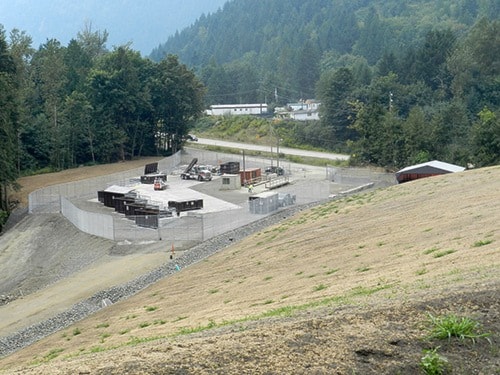The Hope transfer station is now officially open under the operation of First Class Waste Services.
Effective Wednesday (Aug. 13), the new summer hours are Wednesday through Saturday, from 10 a.m. - 8 p.m. Residents will also no longer be required to bag their green waste in favour of a plastic container. Green Waste decals to identify these containers are available for free at district hall.
“The transfer station provides long-term cost savings for the municipality, a cleaner environmental report, and has helped us build relations with our First Nations partners,” said Mayor Susan Johnston. “It’s a huge success and it’s one of the biggest accomplishments that the District of Hope has made.”
With only 10 years left in the site’s life-span, and years of controversy due to environmental concerns, the landfill’s closure was imminent. In early 2013, council approved the construction of a transfer station by JJM Construction Ltd. and granted the four-year operations contract to First Class Waste Services. However, in response to public feedback, council decided to undertake a request for proposals for the operations contract this year. Chief administrative officer John Fortoloczky said there were no responses, and as a result the district reverted back to the original plan.
“An idea was sought upon by one of our consultants, identifying the opportunity to use JJM Construction Ltd. in P3 (public-private partnership) format, where work in kind valued in the neighbourhood of $4 million would establish the closure,” he said. “So instead of the taxpayer paying to close the landfill and improve leachate treatment, that would be highly subsidized by JJM. They took inert material from a Burnaby site and they transferred here to Hope and they filled up the airspace. We were also able to establish a storage plateau at the top which will save taxpayers we figure approximately $160,000 a year in storage for clean fill and other materials that we need for public works. Right now we have to pay to get that hauled away and disposed of.”
The primary goal of the transfer station was to stem leachate pollution, as directed by the Ministry of Environment. The site is located on land with a steep slope toward the Fraser River, and adjacent to First Nations land on the downslope.
The site began as a “crude dump site” similar to those found in many small towns across the province. The district has run the site since amalgamation, taking over operation from the regional district.
The leachate treatment pond encroached on Union Bar land. In 2009, the Ministry of Environment sent the district a non-compliance notice. It cited issues such as lack of cover, lack of cells, excessive litter, poor surface water and ineffective leachate treatment. The leachate treatment system has since been improved.
“We have two new ponds, a wetland, and new aerators,” said Fortoloczky. “We also had water running through the garbage from the south side and we’ve now diverted that water around to the backside so that it actually mixes now with the leachate and dilutes it. Since the leachate treatment system has been running as of Christmas 2013, all tests indicate we are in full compliance with environmental specs.”
The landfill was costing taxpayers approximately $400,000 per year to operate with an additional $175,000 per year set aside annually into a reserve for future closure costs. Those funds can now be diverted to other infrastructure projects.
There is no change in the level of service to commercial and residential collection as a result of the transfer station. Self-haul material can still be dropped off at the former landfill site, but residents will now be required to sort their garbage into bins. Waste will then be hauled away at the expense of First Class Waste Inc. and sent by rail to the Roosevelt Regional Landfill in Washington State.
The transfer station project saw two cost increases from the original estimate, which Fortoloczky said were funded by reserves already set aside. An additional $350,000 was added to cover costs associated with required changes to the design of the leachate treatment system, and changes in design to the transfer station. In addition, the storage plateau on top of the closed landfill cost an additional $38,911.39.
The official grand opening of the transfer station is set for Sept. 4.
